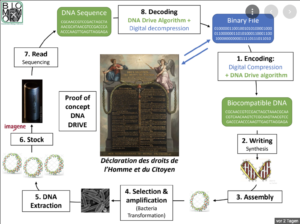The team of Yuan Yingjin from Tianjin University has enciphered 10 digital pictures of Dunhuang murals, a UNESCO world heritage, into 210,000 DNA strands through the nucleotide sequences in a 6.8 MB zipped file. The pictures stored in DNA could be precisely recovered from a severely corrupted solution of this DNA that had been treated at 70 degrees Celsius for 70 days.
The general concept was proposed in 2021 by French researchers and led to a startup company at Sorbonne University, Biomemory. Biomemory has developed a DNA Drive storage technology using synthetic biology to store 5PB of data in stainless steel pellets with contents that can be read by a DNA sequencer.
https://www.club-innovation-culture.fr/dna-drive-revolution-adn-declarations-homme-femme/
https://www.biomemory-labs.com
https://blocksandfiles.com/2022/09/14/biomemorys-bacterial-dna-storage-technology/

The contribution of the Tianjin group consists of DNA storage by synthesizing a yeast artificial chromosome with a length of 254,886 base pairs designed from scratch and dedicated to data storage, achieving stable data replication using yeast propagation, and using nanopore sequencing devices to achieve fast data readout and error-free recovery.
https://www.nature.com/articles/s41467-022-33046-w
Amid rapid digitalization, humans generate millions of gigabytes of data each day. Global data volume will reach about 180 zettabytes (where 1 ZB is 1012 GB) by 2025. Finding economically viable storage solutions for such a massive amount of data is a major challenge.
https://www.nature.com/articles/d42473-022-00319-3
DNA storage still faces many challenges, such as high cost for DNA synthesis, and slow read and write speed.


